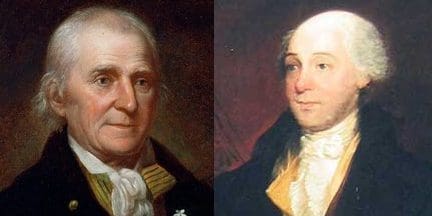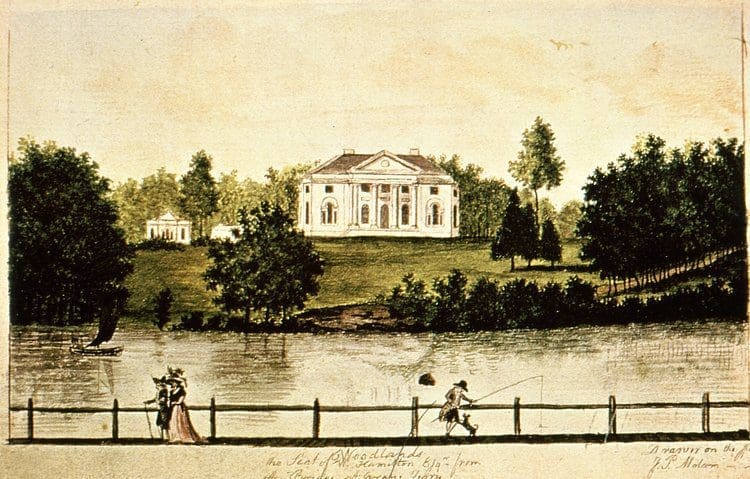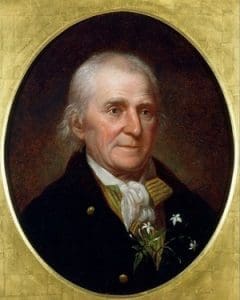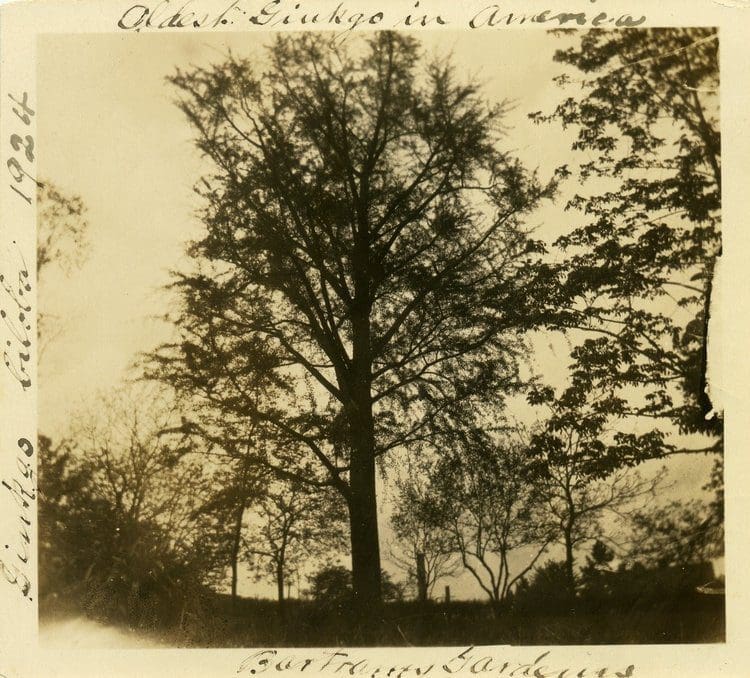Introducing the Two Williams

Did you know that William Hamilton of The Woodlands and William Bartram of Bartram’s Garden were contemporaries and friends? The two shared a love of plant collecting and botany, were neighbors, and were involved in many of the same local institutions! To highlight some of these lesser-known connections, we’re bringing you Two Williams: a six month blog series hosted between The Woodlands and Bartram’s Garden. Each month, we will dig into the archives and share what we find!
Picturing the banks of the tidal Schuylkill as a lush, pastoral landscape takes a bit of imagination these days. But long before it was home to manufacturing plants and oil refineries, the stretch of the River running through Philadelphia to the Delaware was considered one of the most beautiful scenic landscapes in the country. Though much of this revered landscape was lost as the waterfront industrialized, some vestiges were spared. The Woodlands and Bartram’s Garden were both prominent 18th century estates and hubs for the early study of botany and horticulture, separated by just over a mile along the Lower Schuylkill. Safeguarded by early preservation efforts, both are now recognized as National Historic Landmarks, bastions of Philadelphia’s horticultural legacy that live on as parks, historic sites, and important community anchors in their respective neighborhoods.

The Woodlands and Bartram’s Garden shown on an 1808 map surveyed and published by John Hills. (Image: Philageohistory.org)
The Woodlands and Bartram’s share a number of historical themes and connections, which we will be exploring in monthly blog posts. This month, we’ll begin by introducing two key players: William Bartram (1739-1823), son of John Bartram and William Hamilton of The Woodlands (1745-1813). The two men were friends and contemporaries (and, notably, both were both lifelong bachelors) passionate about botany and horticulture in distinct yet complementary ways.

William Hamilton’s mansion as seen from across the river depicted by James Peller Malcom ca. 1792. (Image: Dietrich American Foundation)

Portrait of William Bartram by Charles Wilson Peale, 1808 (Image: Independence National Historical Park)
William Bartram, son of John Bartram (1699-1777), was a gifted naturalist and a very skilled botanical and ornithological artist. Growing up, he accompanied his father on many of his travels and gradually took over the maintenance of the family garden. Later, William spent the years 1773-1776 traveling the southern Colonies studying and collecting plants and animals. He interacted with local Native American tribes and made copious notes and drawings, writing extensively about his findings which were published as Bartram’s Travels in Philadelphia in 1791. Upon returning from his excursion in 1777, William resumed his work maintaining and caring for the family garden and business at Bartram’s with his younger brother John, Jr.

Portrait of William Hamilton and his niece Ann Hamilton Lyle. (Image: Historical Society of Pennsylvania)
Just up the river, William Hamilton (grandson of prominent Philadelphia lawyer Andrew Hamilton, whose defense of John Peter Zenger established freedom of the press) established his estate, The Woodlands, in the style of an English country house. Hamilton inherited the estate from his father in 1747 when he was just two years old and had, over the course of his adult life, parceled together roughly 500 acres along the western bank, including much of what is now the campuses of Penn and Drexel. Hamilton was an Anglophile and an enthusiastic amateur botanist and plant collector. An extended visit to England in the mid-1780s inspired the neoclassical remodel of his Philadelphia estate, recognized as the earliest example of Federal architecture in the country, and heavily influenced his approach to landscape design. Thomas Jefferson, who was a frequent visitor to both Bartram’s Garden and The Woodlands, once remarked that Hamilton’s estate was “the only rival which I have known in America to what may be seen in England.” Hamilton was particularly interested in collecting rare and exotic plants, introducing a number of exotic species to the U.S. through his massive greenhouse complex which is believed to have housed upwards of 9,000 species.
The Woodlands and Bartram’s Garden formed the nexus of the country’s early botany scene and helped spur a regional horticultural economy that persisted for generations. Prominent naturalists, politicians, and members of the gentry would often stop at one or both gardens when traveling into the city. The two Williams frequently connected over their shared interest in plants and botany, often exchanging letters, plants, seeds and services. This relationship is best illustrated in their correspondence, which was frequent and familiar and often involved arranging the viewing, sharing, and trading of plant material.

A photograph of the Ginkgo at Bartram’s Garden from 1924 captioned “Oldest Ginkgo in America.” After William Hamilton imported the first Ginkgo biloba into the country, he kept two on his property at The Woodlands and sent the third as a gift to William Bartram. The two at The Woodlands no longer stand, but the impressive Ginkgo at Bartram’s still does and is recognized as the oldest living example in North America. (Photo: John Bowman Bartram Special Collections Library)
In a letter[1] to William Bartram on November 7, 1796 Hamilton wrote:
Dear Sir
I must beg the favor of you to make a sketch of the Senecio nova, floribunda as it now blooms in my Hot House. For this obligation I will make you any compensation in my power. After this day it cannot be done this Season as its beauty is already on the decline.
I have moreover in my Hands at this moment, just arrived from England near 100 coloured plates mostly of new plants (some of them from Botany Bay) which you ought not to lose the opportunity of viewing & they are immediately to be return’d to the gentleman who left them here. I hope therefore you will oblige yourself as well as me by coming here as soon as you can after receiving this & that you will come prepared to make the sketch I have required, in which I am more interested for the Honor of American gardening than you are aware of. I have seen a figure & description of this plant as it flower’d last season for the first time in Europe, under the name of Senecio Chrysanthemum by which I find it flower’d with me before it was known in Europe.
I am dear Sir truly
Your friend & humble Servt.
W Hamilton
Both Williams also had connections to the University of Pennsylvania, then known as the College of Philadelphia, particularly to Dr. Benjamin Smith Barton, chair of Materia Medica and the sole professor of botany at the university. Bartram’s Garden and The Woodlands functioned as outdoor laboratories to supplement lectures and William Bartram often lent his services as a botanical illustrator to assist Barton. The relationship between the three ensured the university’s position as the best place in the country for the study of botany and both Hamilton and Bartram assisted in procuring and sharing noteworthy and interesting plant specimens. In the following letter, William Bartram writes Dr. Barton about the first blue hydrangea imported to America, on display at William Hamilton’s garden at the Woodlands:
P.S. Come see us as soon as convenient. Have you seen the most beautiful Hydrangia [sic] from china now in flower at Hamiltion’s Gardens at the Woodlands? if not it is well worth a visit. The Cœlestial blue of the flowers is inexpressebly [sic] pleasing. [2]

An Illustration from Frank H. Taylor ca. 1922 showing the Woodlands mansion and John Bartram’s house as examples of country mansions from “a time when the unpolluted tide-water Schuylkill River was bordered by fine country seats.” (Image: Library Company of Philadelphia)
Hamilton frequently entertained guests at The Woodlands and his dinners and his gatherings, more often than not, involved lengthy discussions about plants and botany supplemented by demonstrations of species from his greenhouse. These were sometimes even coordinated around significant bloom times of his most impressive rare species, which would be brought in to the house to be observed and appreciated throughout the meal. In the following letter,[3] Hamilton requests a sample of a particular variety of grape from Bartram to serve the dual purpose of botany and dessert at an upcoming dinner:
My dear Sir
Mr Pursh tells me that he was at your house yesterday & that you shewed him a white grape which you called Blands grape—From what I have heard you say, I have always supposed it a dark fruit & my curiosity is exited to understand the Business. I will therefore thank you to send me a specimen of the fruit by the bearer. If it is ripe & you can spare them, you will oblige me by sending as many as will fill a plate as if the fruit good, it would serve as an interesting part of our Desert [sic] at dinner to day for Mr. & Mrs. Merry whom I expect will be here—
—I am most sincerely
Your friend
W. H.
Stay tuned as we highlight more of the fascinating botanical connections between these two sites!
Upcoming Posts:
– Found in the Floorboards: 200 Year Old Seed Packets
– William Bartram’s Travels and the Early Naturalist’s Library
– Think Local Swap Global: 18th Century Approaches to Plant Collecting
– From Seed Shack to Plant Palace: Evolutions in Greenhouse Technologies
– The 19th Century Commercial Nursery
By Starr Herr-Cardillo
[1] William Hamilton to William Bartram, November 7, 1796, Gray Herbarium Autographs 3:17a, Harvard University.
[2] William Bartram to Benjamin Smith Barton, July 16, 1800, Barton Delafield Collection, American Philosophical Society.
[3] William Hamilton to William Bartram, circa 1803-1805, Bartram Papers 4:49b, Historical Society of Pennsylvania.


